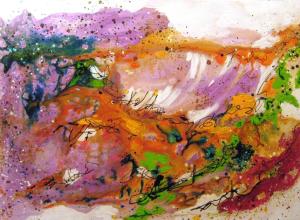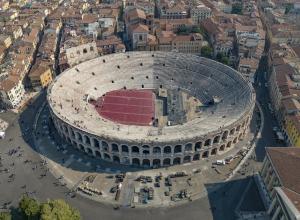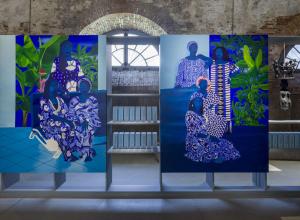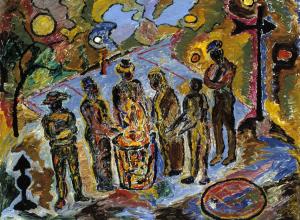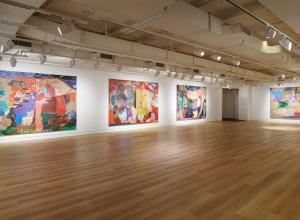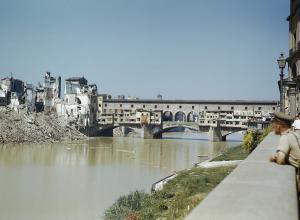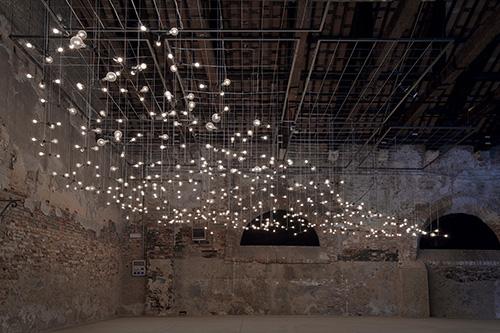
Spencer Finch. Moon Dust (Apollo 17). 2009. Installation view at "Fare Mondi/Making Worlds", Venice Biennial, 2009. Collection of Joanne Gold and Andrew Stern.
BMA ILLUMINATES LOBBY OF HISTORIC BUILDING WITH MOON DUST (APOLLO 17) BY ACCLAIMED AMERICAN ARTIST SPENCER FINCH
Dramatic light work created for 2009 Venice Biennale will be on view for seven years
BALTIMORE, MD —The Baltimore Museum of Art (BMA) is transforming Fox Court, the stately columned lobby in the 1929 building designed by John Russell Pope, for the next seven years with an extraordinary light work by acclaimed artist Spencer Finch. On view February 21, 2018 through October 14, 2024, Spencer Finch: Moon Dust presents an abstract sculpture comprised of 417 LED light bulbs that together represent the molecular structure of the moon dust gathered from NASA’s 1972 Apollo space mission. Finch’s installation conveys scientific information and offers a poetic experience as its glowing composition evokes the sensation of being immersed in a star-filled sky.
“This magical work of art will provide visitors with a dazzling, transcendent experience in the BMA’s neoclassical building,” said BMA Dorothy Wagner Wallis Director Christopher Bedford. “We are thrilled that it will illuminate the museum for such an extended period of time and are very grateful to Baltimore collectors Joanne Gold and Andy Stern who have made this long-term loan possible.”
First presented at the 2009 Venice Biennale, Moon Dust (Apollo 17) creates a precise, three-dimensional scale model of the moon’s atomic makeup. Finch represents the chemical elements of moon dust with light bulbs in varied sizes, arranging them on fixtures in patterns that mimic their bonds in molecules. The differently sized bulbs correspond to the relative weights of elements; the smallest indicating oxygen and the largest signifying both iron and chromium.
“The embrace of rational thought and wonder within Moon Dust’s welcoming expanse of light is an amazing metaphor for the discovery and delight that occurs throughout a visit to a museum like the BMA,” said Senior Curator of Contemporary Art Kristen Hileman. “It has been very rewarding to work with Spencer Finch and the lenders to adapt the piece to the specific architectural context of the BMA’s original building.”
Moon Dust (Apollo 17) is on extended loan from the collection of Joanne Gold and Andrew Stern, who are generously sponsoring its presentation at the BMA in loving memory of Lenore E. Gold.
SPENCER FINCH
With both a scientific approach to gathering data and a true poetic sensibility, Spencer Finch’s (American, b. 1962) installations, sculptures, and works on paper filter perception through the lens of nature, history, literature, and personal experience. Finch’s work has been a part of Baltimore’s cityscape since 2012, when Johns Hopkins Hospital unveiled the artist’s 25,000-square-meter glass façade for its medical center on Broadway. Other major projects include Painting Air, an installation at the Rhode Island School of Design Museum of Art in which more than 100 panels of suspended glass refract and distort an abstract mural inspired by the colors of Claude Monet's garden at Giverny; Lunar, a large sculpture commissioned by the Art Institute of Chicago that gathers sunlight during the day and releases that solar energy as a glow at the precise color temperature of a full moon; and The River That Flows Both Ways, an installation on New York’s High Line that transforms a series of windows with 700 individual panes of glass representing various water conditions on the Hudson River.
Spencer Finch has had extensive international solo exhibitions and projects including The Western Mystery at Seattle Art Museum, Seattle, WA (2017); A Certain Slant of Light, The Morgan Library & Museum, New York, NY (2014); Spencer Finch: The Skies can’t keep their secret, Turner Contemporary, Margate, UK (2014); Spencer Finch: My Business, with the Cloud, Corcoran Gallery of Art, Washington, DC (2010); and As if the sea should part And show a further sea, Queensland Gallery of Modern Art, Brisbane, Australia (2009). He has taken part in numerous group exhibitions at The Fruitmarket Gallery in Edinburgh, UK; The Solomon R. Guggenheim Museum in New York, NY; 53rd International Art Exhibition at La Biennale di Venezia; and the Turin Triennial. His work can be found in the collections of the Hirshhorn Museum and Sculpture Garden, Washington, DC; the High Museum of Art, Atlanta, GA; the Museum für Moderne Kunst, Frankfurt, Germany; The Kemper Museum of Art, St. Louis, MO; The Rhode Island School of Design Museum of Art, Providence, RI; the Museum of Contemporary Art in Chicago, IL; and the Solomon R. Guggenheim Museum. Finch lives and works in Brooklyn, New York.
THE BALTIMORE MUSEUM OF ART
Founded in 1914, The Baltimore Museum of Art is a major cultural destination recognized for engaging diverse audiences through dynamic exhibitions and innovative educational and community outreach programs. The BMA’s internationally renowned collection of 95,000 objects encompasses more than 1,000 works by Henri Matisse anchored by the famed Cone Collection of modern art, as well as one of the nation’s finest holdings of prints, drawings, and photographs. The galleries showcase an exceptional collection of art from Africa; important works by established and emerging contemporary artists; outstanding European and American paintings, sculpture, and decorative arts; significant artworks from China; ancient Antioch mosaics; and exquisite textiles from around the world. The 210,000- square-foot museum is also distinguished by a grand historic building designed in the 1920s by renowned American architect John Russell Pope and two beautifully landscaped gardens featuring an array of 20thcentury sculpture. The BMA is located in Charles Village, three miles north of the Inner Harbor, and is adjacent to the main campus of Johns Hopkins University. General admission to the BMA is free so that everyone can enjoy the power of art.
VISITOR INFORMATION
General admission to the BMA is free. Special exhibitions may be ticketed. The BMA is open Wednesday through Sunday from 10:00 a.m. – 5:00 p.m. The museum is closed Monday, Tuesday, New Year’s Day, July 4, Thanksgiving, and Christmas. The BMA is located at 10 Art Museum Drive, three miles north of Baltimore’s Inner Harbor. For general museum information, call 443-573-1700 or visit artbma.org.





